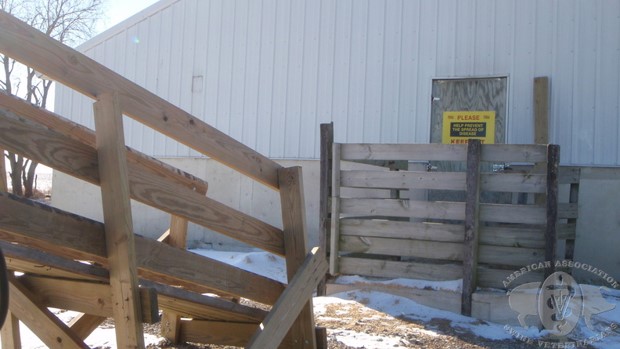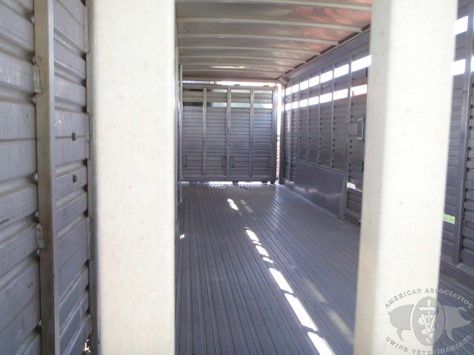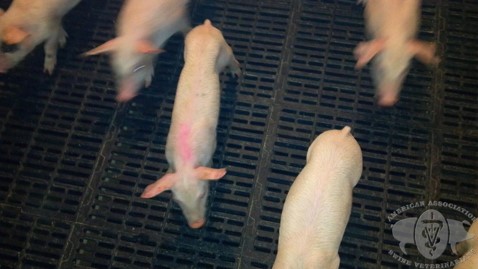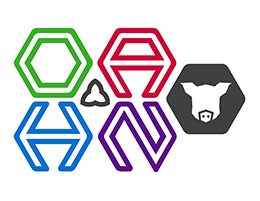Swine Industry Report – Q1 2025
Ontario Animal Health Network (OAHN) Swine Network Quarterly Veterinary Report
3 New OAHN Swine Projects
The OAHN swine network recently received approvals for three research projects. The network is very excited to get these projects underway and to contribute meaningful findings to the industry. Dr. Christa Arsenault provided the group with an overview of all three projects and their objectives.
Project #1- The first project aims to assess Porcine Circovirus type 2 (PCV2) prevalence in the Ontario herd, specifically the different PCV2 subtypes. PCV2 PCR-positive samples submitted to AHL are eligible, and this project will sequence these samples to determine subtype. These results will allow for better understanding of the distribution of different PCV2 subtypes within the province. A short survey will accompany these submissions to better understand clinical picture of each case.
Project #2- The second project will focus on the neonatal diarrhea complex and the role of Sapovirus in these cases. Eligible cases will be those with piglets less than 20d of age presenting with a clinical scour and an accompanying Sapovirus PCR-positive result. This project will evaluate these cases by testing for a wide range of pathogens, including: porcine bacteriology enteric panel, Rotavirus PCR, Sapovirus PCR, Coronavirus triplex PCR, fecal flotation, and histopathology. This project aims to allow for better understanding of how Sapovirus contributes to neonatal diarrhea cases, especially amongst other common pathogens.
Project #3- The final project will assess the current parasitic burden on Ontario Swine farms. Both provincial and federal abattoirs have reported a high frequency of parasitic livers (attributed to ascarids), and this project will strive to better understand this recent increase. Pen-based fecal samples from sows and finishing pigs will be collected and submitted for fecal flotation, and a brief survey will collect information on current deworming practices in enrolled herds. This will quantify the load of parasites on farms, as well as the deworming protocols currently being used in the field, to give more context to these high condemnations.

More information will be provided to Ontario swine veterinarians on the details of these projects including an overview of all project requirements at the OASV AGM meeting planned for the evening of June 19, 2025, after the Ontario Pork Congress in Stratford. For those that cannot attend this meeting in person project summaries will be disseminated to all OASV members through the email listserv. Any questions can be directed to Dr. Christa Arsenault
Porcine Epidemic Diarrhea (PEDV)/ Porcine Deltacoronavirus (PDCoV)
Jessica Fox the manager of Swine Health Ontario (SHO) provided an update on PED and PDCoV cases seen in Q1 of 2025. Jessica reported that this quarter has been the worst quarter seen since 2014, with 20 reported PED cases and 18 reported PDCoV cases. Most of these cases occurred in January (at the start of the quarter). As part of SHO’s ongoing goal to spread awareness to reduce transmission of these viruses, SHO leadership team members have been meeting with various industry sectors to discuss the importance of ongoing biosecurity, including pork producers, feed companies, transporters, and packing plants. At the start of Q2, SHO sent out a memo to remind industry members of the risks of PED/PDCoV movement associated with manure spreading. Jessica reported that 21 previously detected cases resumed negative PED/PDCoV status in Q1. SHO’s reporting website is constantly being updated. Moving forward, SHO continues to urge industry stakeholders to remain as vigilant as possible in the face of these viruses, as new detections continue to be reported in Q2.
SHO continues to support elimination as the best strategy for disease control. Practitioners are encouraged to continue to be diligent in testing for coronaviruses in all gastrointestinal cases, as PDCoV can present with minimal clinical signs. Timely diagnosis of these cases can help limit widespread contamination and potential spread to other sites.
Practitioners are also encouraged to promote the use of SHARC by producers to stay aware of current positive sites in their proximity. Please refer any producers interested in enrollment to Jessica Fox Jessica.fox@swinehealthontario.ca. The PED and PDCoV Tracking map is available on the Swine Health Ontario website and shows current and annual cases by county. http://www.swinehealthontario.ca/Disease-Information/PED-PDCoV-Tracking-Map


International Disease Topics Of Interest Summary
Foot and Mouth Disease (FMD) International Increase in Cases
Dr. Al Scorgie provided and update on the increase seen internationally in Foot and Mouth Disease (FMD) cases.
Germany: In mid-March, Germany was declared free of FMD after there were no further FMD outbreaks and no FMD detected in the surveillance and control zones, after the initial outbreak of FMD reported in a small herd of water buffalo, (14 animals), on January 10th, 2025. This herd was located near Berlin in an area with few farms which made control easier. The source of the FMDV is unknown. One of the challenges in Germany at this time is the outbreak Bluetongue virus. Bluetongue virus can cause lesions that are similar to the lesions caused by FMD. Germany has reported over 15,000 cases of Bluetongue since May 2024. Source: (Pig333.com, March 17th,2025)
Hungary: On March 06th, 2025, Hungary confirmed a case of FMD on a cattle farm, with 1600 cattle. The farm started showing clinical signs on March 03rd, 2025. By mid-April, Hungary had confirmed a total of 5 cases of FMD. Cases are detected in the same county that has previously had four FMD outbreaks. The strain of FMDV in Hungary is different from the strain of FMDV that was detected in Germany and there is no link to the FMD outbreak in Germany. The affected farm in Germany was 765 kms from the affected farms in Hungary. Hungary has not had FMD for over 50 years. Source: (CEZD Weekly Intelligence Report April 14th -20th 2025 and Pig333.com, March 17th,2025)
Slovakia: On March 20th, 2025, Slovakia reported an outbreak of FMD on 3 cattle farms in the district of Trnavsky in southwest part of the country. A fourth outbreak on a cattle farm in the same area was reported on March 24th. The farms are located within 10 kms of the border with Hungary and 35 kms from the first reported outbreak of FMD reported in Hungary. Germany has sent 10,000 doses of FMD vaccine to Slovakia. Source: (Pig Progress)
UK: Authorities in the UK realized that although a ban on the import of meat and meat byproducts from Germany had been put in place, these products were still entering the country. A gap was identified where trucks entering the country cross the border first and then enter a custom inspection station. Some trucks were not entering the station.
Topics of Interest- Can PRRS Circulate through soil into groundwater?
Dr. Al Scorgie provided a summary on a recent article published by the University of Minnesota to determine if PRRS can circulate through soil into groundwater.
The study was done because in the fall when PRRS breaks usually increase there is manure spreading. Could PRRSV enter the groundwater and be a risk to farms? The researchers used 3 different PRRS strains: L1A 1-7-4, L1C.5 1-4-4, L1G 1-26-2. Thirteen different soil types from Minnesota were tested. Also, the viruses were percolated through different amounts of soil. The researchers found that the different strains of PRRSV could percolate through the soil although there were differences among the strains on how much soil the PRRSV could percolate through. For example, the L1G 1-26-2 strain was able to percolate through more of the samples. Also, all the strains could percolate through all the soil types. The researchers commented that this is an initial study, and further work needs to be done. The amount of soil the viruses were run through was small. There could be virus dilution, in the field there could be multiple layers of soil layers and further study has to be done on infecting pigs with contaminated groundwater. Source: (Joaquin et al. Comparative Adsorption of Porcine Reproductive and Respiratory Syndrome Virus Strains to Minnesota Soils, Viruses 2025, 17, 58).
Topics of Interest- PED Transmission- Nasal to Intestinal Mucosa
Dr. Sue Burlatschenko provided a summary on a recent article published by Nature Communications to discuss potential alternate routes of PED transmission.
This paper discusses the nasal mucosa as a “gateway for pathogens” into the GI tract via the intranasal route. In swine, dendritic cells are distributed in the nasal mucosa, where they capture antigens and migrate to the lymph nodes to present them to T cells. Interestingly enough, these submucosal dendritic cells can evade antiviral immune responses at the epithelial barrier, allowing these viruses to be disseminated in the submucosa through increased cells, and then go to lymph nodes, and further transfer to T lymphocytes. This study reports that dendritic cells show a certain susceptibility to PED virus, and following the above pathway, allow PED-infected T cells to migrate to the small intestine to then cause disease. Two groups of pigs were infected with PED – one intranasally and one orally. The orally-infected pigs developed traditional clinical signs within 46hr. The intranasally-infected pigs developed clinical signs in about 60hr, including the associated pathology (IFA positive in their small intestines), and PED virus was identified within T cells 24hr post-inoculation. This study shows that aerosolized PED virus can effectively infect pigs via the intranasal route. Source: (Nature Communications, Y Li et al, Sept 19, 2018.
 Photo demonstrates gaunt pigs that were infected with PED/PDCoV. Source: AASV
Photo demonstrates gaunt pigs that were infected with PED/PDCoV. Source: AASV
How can you Participate in OAHN?
Share the information contained within this report with others involved in the swine industry and with other swine producers. Help us spread the word!
Ask your veterinarian for more information about topics included in this report.


